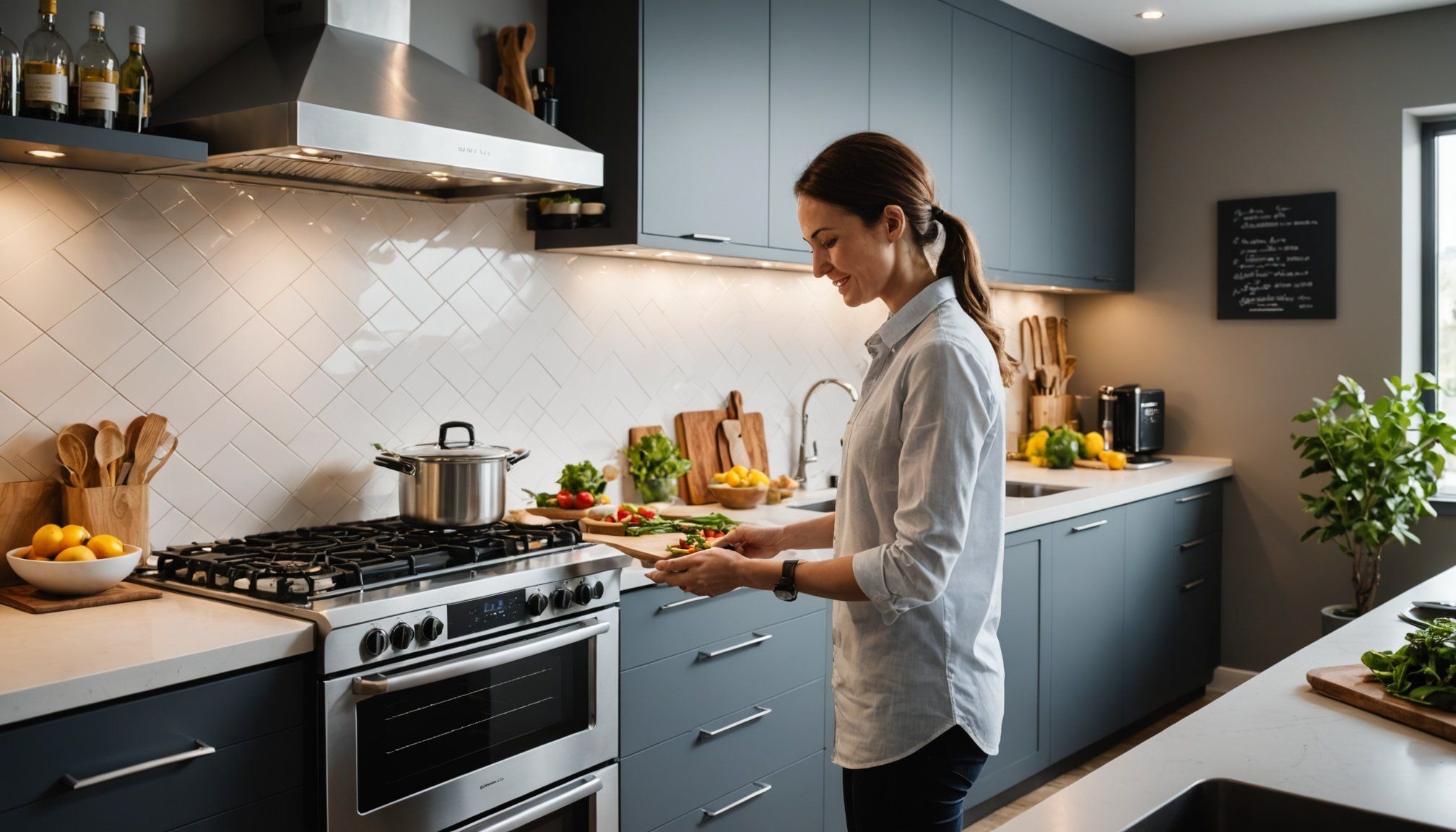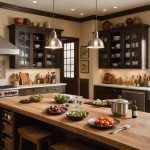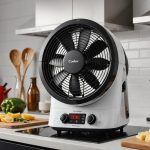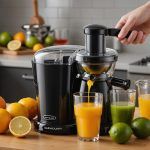Importance of Ergonomics in Kitchen Design
Ergonomics is the science of designing environments to fit the users and optimizing comfort and efficiency. In the context of kitchen design, ergonomics plays a crucial role in promoting healthy cooking habits by enhancing the efficiency and comfort of the space. A well-structured kitchen layout ensures that chefs can work fluidly, reducing unnecessary movement and strain.
The layout of a kitchen significantly influences cooking efficiency and comfort. An ergonomically designed kitchen places commonly used items within easy reach, minimizing the time and effort spent on preparation and cooking. Efficient design means organizing key elements, like the stove, sink, and refrigerator, in a triangular setup known as the “kitchen work triangle.”
Also read : Maximize space and elevate efficiency: discover the advantages of a foldable kitchen step stool
Ergonomics also fosters healthier eating habits. When a kitchen enhances user comfort, it encourages more time spent on meal preparation, potentially leading to more nutritious meals cooked at home. An organized, ergonomic kitchen motivates individuals to engage in the cooking process, making healthy eating more accessible and enjoyable. Prioritizing ergonomic design in the kitchen transforms it into a space where health and practicality intersect harmoniously.
Optimal Placement of Cooktops
Placing cooktops strategically is fundamental in achieving cooking efficiency and supporting an ergonomic kitchen design. The right cooktop placement enhances workflow efficiency and reduces fatigue, promoting a more enjoyable cooking experience.
In the same genre : Stylish Water Dispenser Innovations to Boost Your Diet-Focused Kitchen Hydration Routine
Ideal Height for Cooktops
The recommended height for cooktops typically ranges between 34 to 36 inches from the floor to the countertop. This height accommodates the average individual without causing strain. For those of varying heights, adjustable or customizable designs can accommodate differences, helping maintain proper posture. Proper height alignment helps prevent cooking fatigue, by minimizing the need to bend excessively.
Proximity to Preparation Areas
Ensuring accessibility between the cooktop and prep areas is crucial for a seamless cooking process. A unified design integrates cooktops closely with preparation zones, reducing unnecessary walking and enhancing workflow efficiency. Effective placements may involve situating prep countertops adjacent to cooktops, like in many open-plan designs.
Safety Measures for Cooktop Design
Using safe materials and surfaces is vital to secure cooktops while minimizing clutter around them further enhances safety. Incorporating features like heat-resistant surfaces and splashbacks are necessary considerations. Safety-conscious ergonomic design can significantly prevent accidents and improve the user’s confidence in the kitchen environment.
Strategic Oven Placement
In kitchen design, strategically positioning the oven greatly influences both cooking efficiency and the overall ergonomic layout.
Placement Techniques
Placing the oven at a suitable height ensures easy access and reduces physical strain. Recommended heights consider user convenience, often aligning with adjacent countertops to minimize excessive bending or reaching. For wall-mounted ovens, placement at eye-level eases checking and handling hot dishes, improving safety. Choosing between wall-mounted versus free-standing ovens depends on kitchen space and user preference, but both should enhance workflow. Positioning the oven near other appliances, like the refrigerator or prep areas, further optimizes efficiency by streamlining cooking tasks.
Avoiding Strain During Cooking
Reducing strain during cooking is crucial for maintaining long-term health. Ergonomic oven placement prevents common mistakes, such as excessive reaching or bending. Proper height and easy-to-grip handles are essential features. An ideal oven height aligns with the user’s waist, promoting a healthy posture and reducing potential back pressure during use.
Integration with Other Kitchen Appliances
Successful integration with other kitchen appliances is key to cohesive design. Maintaining a consistent flow between the oven, stove, and other major elements reduces unnecessary movements. This cohesive design supports a functional and visually pleasing environment, enhancing the kitchen’s utility.
Additional Ergonomic Considerations
When designing a kitchen, focusing on the overall kitchen workflow is crucial for maintaining an ergonomic space conducive to comfort and efficiency. An effective workflow minimizes unnecessary steps, allowing users to transition smoothly between tasks, which is a cornerstone of ergonomic design principles.
Recommendations for versatile kitchen layouts highlight the importance of adaptability. By considering different user needs and preferences, these layouts can accommodate a range of cooking styles and activities. Flexible designs often include adjustable countertops and modular storage options, ensuring that every aspect of the kitchen caters to the user’s ergonomic requirements.
User testimonials frequently emphasize the significant impact of ergonomic improvements on their daily lives. Many users report experiencing reduced fatigue and enhanced enjoyment while cooking, attributing these benefits to thoughtful design choices. Testimonials reveal that ergonomically designed kitchens not only improve the cooking process but also promote a more pleasant and health-conscious environment.
By adhering to practical design principles and considering real user experiences, kitchen designers can create spaces that truly support cooking comfort. A focus on ergonomics in the kitchen promises lasting benefits, both in functionality and the overall well-being of its users.
Real-Life Case Studies
Exploring real-life case studies unveils the transformative power of ergonomic kitchen design in enhancing cooking habits and overall well-being. These case studies showcase practical applications of ergonomic principles, underscoring their impact on both domestic and professional cooking environments.
Domestic Kitchen Transformations
In many domestic kitchens, ergonomic interventions have reshaped cooking routines significantly. By arranging workspaces to minimize unnecessary movements, these redesigned kitchens make meal preparation more efficient and enjoyable. Homeowners often report improved health outcomes, as the new layouts encourage more frequent and healthier home-cooked meals. For instance, an adjustment in countertop height to suit a family’s average stature can noticeably reduce back strain and fatigue.
Professional Cooking Environments
In professional kitchens, ergonomics proves pivotal for chef productivity and health. Culinary experts adopt best practices such as organizing tools and ingredients within easy reach, minimizing repetitive stress injuries. These adjustments lead to a more streamlined workflow and increased job satisfaction among kitchen staff. A well-placed cooktop or adjustable shelving can dramatically enhance efficiency in high-pressure settings like restaurants.
Expert Tips from Interior Designers
Interior designers emphasize common pitfalls and solutions in kitchen ergonomics. They advocate for balancing aesthetics with functionality, ensuring spaces cater to users’ needs. Designers also highlight emerging trends, like adaptable workstations, ensuring kitchens remain future-ready while maintaining ergonomic integrity.








